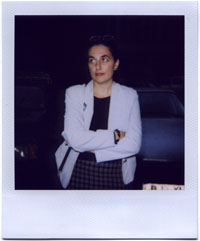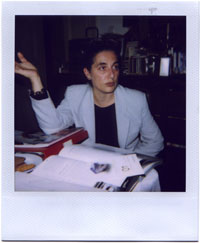 From
a clearer and theoretically derived position things started for me in 1993,
when we made the first exhibition of which we stated that it has a feminist
platform.
From
a clearer and theoretically derived position things started for me in 1993,
when we made the first exhibition of which we stated that it has a feminist
platform. Roxana Trestioreanu
Roxana Trestioreanu, born in 1957, is visual artist and curator. She graduates from the Bucharest Art Academy in painting in 1981. Lecturer and Head of the Faculty of Photography and Video at the University of the Arts, Bucharest.
- You are one of the few women artists whom I met here in Romania who openly state that they are interested in gender and feminist questions in their work, and freely speak about this. Why, how do you explain this?
 From
a clearer and theoretically derived position things started for me in 1993,
when we made the first exhibition of which we stated that it has a feminist
platform.
From
a clearer and theoretically derived position things started for me in 1993,
when we made the first exhibition of which we stated that it has a feminist
platform.
It was called "I, I, I" in the three languages used in Romania, which are Romanian, Hungarian and German. "Eu, En, Ich", a multimedia exhibition, together with Magda Carneci, a poet, and Marilena Preda Sanc, whom you know. We used a poem of Magda's with a dadaist tone to develop the concept of the exhibition.
- What were the reactions of the critics and of the public, how was the exhibition perceived?
At the opening there were many people, among them were some of the most famous men critics. One of them came up to us and said to us: "I like your work as painters a lot, the two of you with Marilena, and that's why I will not write about what is happening here, in order not to destroy your career." After the opening not a single critical article appeared, there was no commentary on the exhibition whatsoever - neither positive nor negative. Only three months later an article was published by Alexandra Titu. We "forced" Magda, who is a poet, as I already mentioned, to speak to "22" - this is an important newspaper for the Romanian cultural context - about the exhibition. Dan Perjovschi, who was a reporter and representative of this newspaper at the time, categorically refused to write anything whatsoever about this exhibition and its topic.
- What was the context in which you developed this exhibition, why did you choose to make it at precisely that moment?
Because for sure we did not want to keep silent any longer! And we could not, either. We wanted our voice to be heard. The first negative reaction came from men in responsible positions with a status in the institutions linked to art and culture.
At the beginning we had the idea to make two exhibitions which were to develop feminist questions. First an exhibition with women artists in Germany, and then here in Bucharest. But it is very hard to work with women artists. We decided that a small exhibition, for a start, would be easier to realize. We asked Magda to record a tape with her poem, and with Marilena we took our works to the gallery. In my space and that of Marilena the poem could be heard, but with a time delay between the two spaces. The result was a sound that created the feeling that you are in a much larger space. We also installed the poem on the wall as a text. What was important to us in this exhibition was to search for our identity. It was not only about our problems on the gender level, as some colleagues understood it to be.
- And after this exhibition how did you continue, did you start to try to develop some context?
I started to be more interested in feminist and gender questions on the theoretical level. Now it dawns on me that, I think, I saw you at VideoMedea in Novi Sad in 1997. My participation in this event was very important for me, and what was really good after my presentation at the festival is that they invited me to make a selection of films of my students for the next edition of the festival, the topic was "Survival."
After that in 1999 I organized an international seminar on the topic "Gender and Age" on how this question linked to aging is presented in art. There were several women from abroad at the seminar, Biljana Tomic from Novi Sad, women from the Netherlands and some other countries. Nobody came from Bulgaria, I don't remember, maybe it was my fault and I did not invite anyone from there.
The seminar turned out to be quite interesting, there were interesting results, but those who had a negative relation to the seminar were the journalists. We invited some journalists from the local mass media to participate, because the object of the seminar was media and art, but also how this question is treated in magazines, newspapers, the electronic mass media. But we received only refusals to participate from the journalists, from most of them with the argument: "We are not interested in gender and feminist questions." Apparently what excites them is only superficial stories, no deeper analysis.
- How about among the younger generation, you teach, are there, among your students, some who are interested in these questions, do you have any information about how things are developing in academic circles?
Yes, now things are different, little by little the context is changing, a deeper interest is making its appearance, with a clearer theoretical foundation and a striving for analysis. In one of the state universities they created a master's program for gender studies, and as far as I am informed, there are quite a few students interested in it. An important contribution to all this are the activities of the center for feminist studies "Ana" and of its founder Laura Gruenberg, a remarkable woman. At the moment she is working as a coordinator of the Unesco for Romania.
 -
Don't you think that the activities of such centers are quite institutionalized
and that it is typical of NGOs that their work lacks transparency?
-
Don't you think that the activities of such centers are quite institutionalized
and that it is typical of NGOs that their work lacks transparency?
What they are doing seems important to me. They also publish a magazine for feminist studies, AnAlize, in which they publish analyses, philosophical and literary texts by Romanian authors, as well as some translated texts, information and news.
I'd like to get back to the problem with the public. This problem is still going on, see for instance in 1999 I participated in "In Full Dress", curated by Liviana Dan. The curator used the English title for the exhibition, the idea was about how you impose your style on others, about people who have a clear position, put their stamp on the world. The women artists exhibited photographs and objects, at the opening there were performances. The way this exhibition was perceived by the public at its opening was very strange. Some people from the public saw the performances at the opening and were speaking about them like of a fashion show, they perceived us as fashion artists…
- As I am looking through the catalog of "In Full Dress" it strikes me how you use a visual language which is characteristic of the 70ies in Western Europe. Are you not trying to pose questions, to speak, to look for identity through old methods that are already history and are being criticized by some theorists, who are looking for new methods and practices for creating alternative exhibitions linked to feminist discussions? I permit myself to ask this question because it personally interests me. This shift in time and space is somehow characteristic also for what is being done in Bulgaria.
I am very interested, from a theoretical point of view, in how women during the 70ies started out. Because this is a period in which the possibilities of visual language as a whole are broadened. I'm interested in how they started using in new ways techniques that are typical of women, like textile, and to transfer them into the fine arts, while at the same time trying to develop new artistic practices. From one moment on we can see how things that had not been allowed within the fine arts, in terms of materiality and transparency, show up in the works of women artists. They introduce also a new sensitivity, which is characteristic of women. Geta Bratescu has a very important series called "Media" from that period. Other women have used more traditional techniques at the beginning, like Marilena, in order to express this new sensitivity. At the beginning I also used, for my painting, well-known materials, but these old works were about inner and outer destruction. In 1986 I made an exhibition with nudes, at the time nudes were half-forbidden. In the exhibition I tried to sharpen the sensation of body and gender. It was about the situation of being looked at, to some extent, as an object. These drawings were not large at all and were presented in small boxes attached to the wall. The question of our own identity has always intrigued me - who are we?
At the moment I am working on my doctorate. The topic is "Feminist Art and Feminist Questions in Romanian Art in the 70ies." Women in Romania have not only actively participated in exhibitions during this period, but have pushed things forward. Women are always very important for promoting small steps, innovations, they are not interested in spectacles, advance step by step looking for new methods.
Dimitrina Sevova - In Someone Else's Skin (2001)
Index of the Interviews